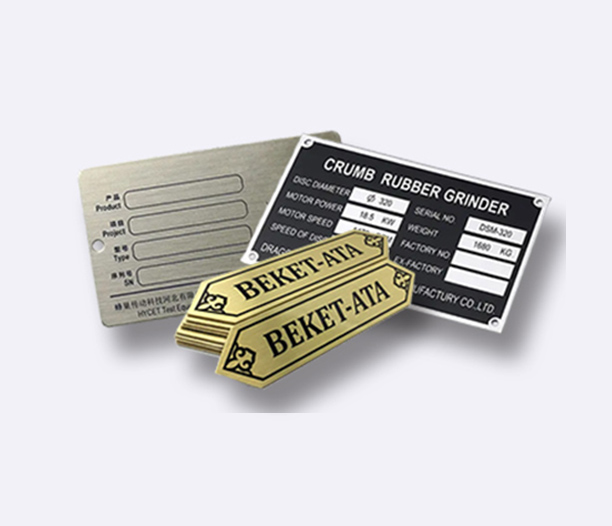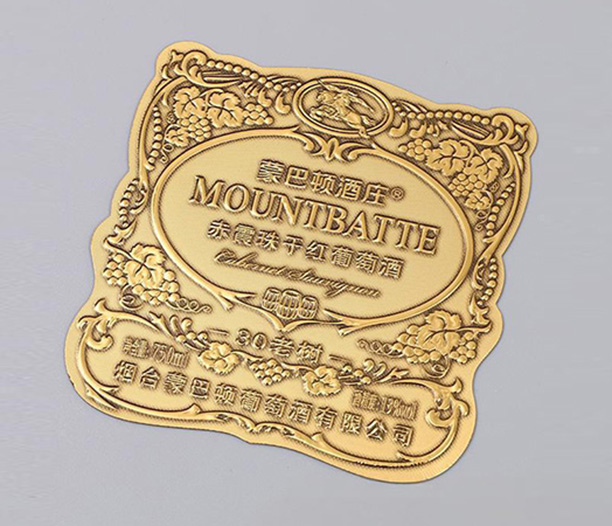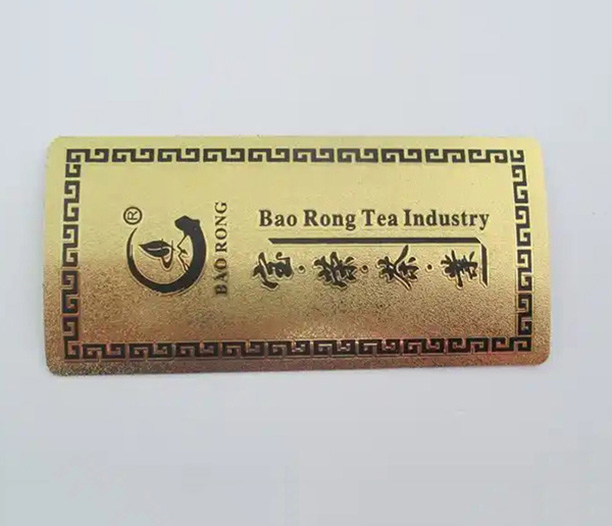In the complex world of industrial machinery, manufacturing equipment, and critical infrastructure, clear, permanent identification isn't just helpful – it's fundamental to safety, efficiency, compliance, and longevity. Metal name plates for equipment stand as the undisputed champions of reliable asset identification. Far surpassing alternatives like plastic or vinyl labels, these durable markers provide an indispensable solution for a multitude of operational needs. This article delves deep into seven crucial aspects that make metal name plates for equipment an essential investment for any organization relying on machinery and assets.
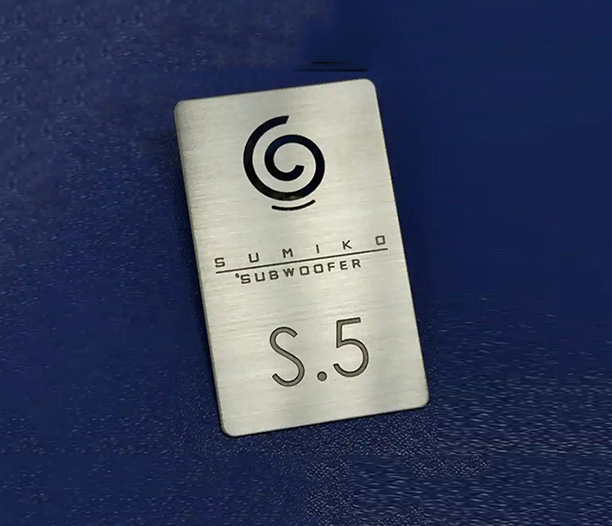
1. Unmatched Durability & Longevity: Built to Withstand the Toughest Environments
The primary and most compelling advantage of metal name plates for equipment is their exceptional resilience. Equipment often operates in punishing conditions:
Extreme Temperatures: Foundries, engine rooms, freezers, and outdoor installations subject labels to intense heat, cold, and thermal cycling. Metal plates (especially stainless steel or high-grade aluminum) resist warping, cracking, and melting far better than plastics.
Harsh Chemicals & Solvents: Industrial cleaning agents, lubricants, fuels, acids, and alkalis can rapidly degrade plastic labels, causing ink to run or the material itself to dissolve. Metal name plates for equipment, particularly those with chemical-resistant coatings or made from inert metals like stainless steel, offer superior resistance to corrosion and chemical attack.
Abrasion & Physical Impact: Tools, parts, cleaning brushes, and general wear-and-tear constantly threaten surface labels. Metal plates resist scratching, gouging, and impact damage, ensuring the critical information remains legible.
UV Radiation & Weathering: Outdoor equipment faces constant sun exposure, rain, snow, and humidity. UV rays bleach plastic and fade inks, while moisture causes adhesives to fail. Anodized aluminum or etched stainless steel metal name plates for equipment retain their integrity and legibility for decades under sun and rain.
Oils, Grease, & Grime: Industrial environments are inherently dirty. Metal plates can be easily cleaned without damaging the information, unlike porous plastics that trap grime.
This inherent toughness means metal name plates for equipment last for the entire operational lifespan of the asset, often decades, eliminating the recurring cost and downtime associated with replacing worn-out plastic labels. The information – serial numbers, ratings, warnings – remains reliably present.
2. Essential for Safety & Regulatory Compliance: Protecting People and Avoiding Fines
Metal name plates for equipment are not merely convenient; they are often legally mandated and critical for workplace safety:
Warning Labels & Hazard Communication: OSHA (Occupational Safety and Health Administration), ANSI (American National Standards Institute), and international standards (ISO, IEC) require clear, permanent warnings for electrical hazards (voltage, arc flash), crush points, pinch points, rotating machinery, high temperatures, radiation sources, and chemical exposures. Metal name plates for equipment are the preferred medium for these critical safety messages due to their permanence and resistance to environmental degradation. Faded or missing warnings can lead to catastrophic accidents.
Equipment Ratings & Certifications: Underwriters Laboratories (UL), Canadian Standards Association (CSA), CE marking, and other certification bodies often require permanent nameplates displaying crucial ratings (voltage, amperage, pressure, temperature, horsepower), model numbers, serial numbers, and certification marks. These plates are subject to audit. Metal name plates for equipment ensure this mandatory information remains intact and verifiable throughout the product's life.
Traceability & Recall Management: In industries like aerospace, medical devices, and automotive, strict traceability regulations require unique, permanent identifiers on critical components. Metal name plates for equipment (often with engraved or stamped serial numbers) provide the tamper-evident and durable identification needed for tracking components from manufacture through service and potential recalls.
Lockout/Tagout (LOTO): While not the tag itself, the equipment identifier on a permanent metal name plate is crucial for accurately applying LOTO procedures, ensuring energy sources are properly isolated during maintenance, preventing accidental energization.
Failure to maintain compliant, legible identification can result in severe penalties, work stoppages, and, most importantly, increased risk to personnel. Metal name plates for equipment are a foundational element of a compliant safety program.
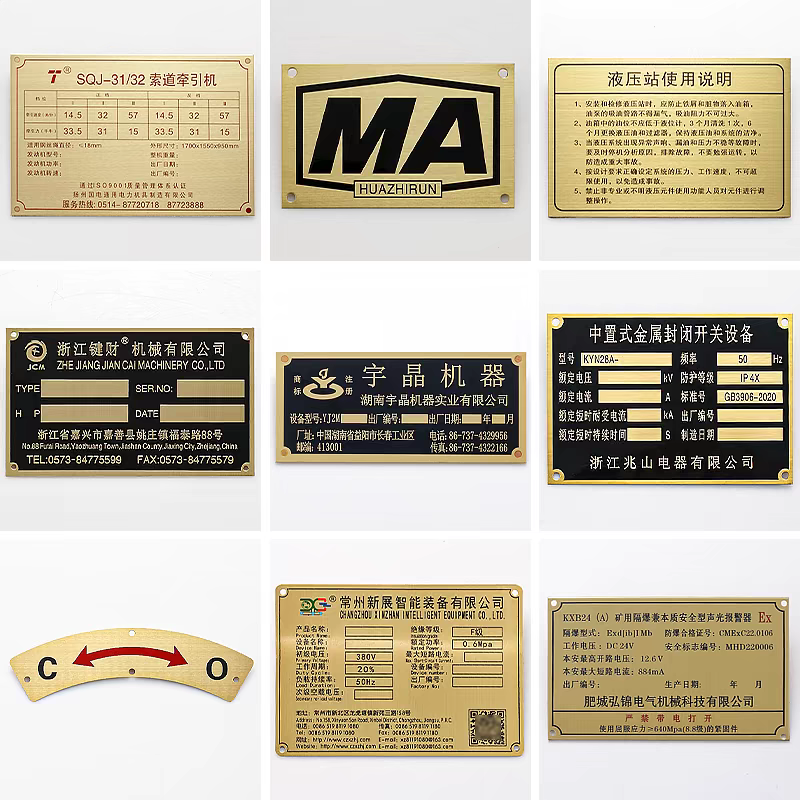
3. Material Selection: Choosing the Right Metal for the Job
Not all metal name plates for equipment are created equal. Selecting the optimal material is critical for performance and cost-effectiveness:
Anodized Aluminum: The most popular choice for general industrial use. Offers an excellent balance of:
Durability: Hard anodizing creates a very tough, abrasion-resistant surface.
Corrosion Resistance: Naturally corrosion-resistant; anodizing enhances this further.
Cost-Effectiveness: More affordable than stainless steel.
Printability/Engravability: Excellent surface for screen printing, digital printing, etching, and engraving. Colors (including durable colored anodizing) are vibrant and long-lasting. Lightweight.
Stainless Steel (e.g., 304, 316): The premium choice for the harshest environments:
Superior Corrosion Resistance: Essential for marine environments, chemical processing, food & beverage, pharmaceutical, and highly corrosive atmospheres. Grade 316 offers even greater resistance to chlorides/salts.
Extreme Durability: Highly resistant to abrasion, impact, and high temperatures.
Hygienic Properties: Non-porous surface is easy to clean and sterilize, crucial for food, medical, and cleanroom equipment.
Methods: Typically etched, engraved, or dot peened for permanent markings. Can also be screen printed with specialized inks.
Brass & Bronze: Often chosen for:
Decorative Applications: Where a traditional, high-end aesthetic is desired (e.g., historical replicas, architectural elements on equipment).
Specific Corrosion Resistance: Good resistance to saltwater and certain chemicals.
Electrical Conductivity: Sometimes relevant for grounding tags.
Methods: Commonly engraved, etched, or stamped.
Zinc Alloy (Zamac): Primarily used for:
Die-Cast Plates: Complex 3D shapes or plates requiring raised lettering/logos formed during casting. Often used for automotive VIN plates or specific industrial applications needing a unique form factor.
Cost-Effectiveness for Complex Shapes: Efficient for high-volume casting.
Durability: Good, but generally less corrosion-resistant than anodized Al or SS. Often plated or coated.
The choice depends heavily on the operating environment, required lifespan, regulatory needs, aesthetic preferences, and budget. Consulting with a reputable metal name plates for equipment manufacturer is key to selecting the right material.
4. Information & Customization: Conveying Vital Data Clearly and Permanently
Metal name plates for equipment serve as the permanent data repository for critical asset information. The content they carry is as important as their durability:
Core Information Typically Included:
Manufacturer Name & Logo
Equipment Model Number
Unique Serial Number (Crucial for warranty, service, tracking)
Electrical Ratings (Voltage, Amperage, Phase, Frequency, Power)
Pressure/Temperature Ratings (for vessels, piping, HVAC)
Safety Warnings & Certification Marks (UL, CSA, CE, ETL, etc.)
Date of Manufacture
Barcodes/QR Codes (For automated asset tracking)
Part Numbers (For components)
Instructions (Startup, Shutdown, Basic Operation)
Hazard Pictograms (ANSI/ISO Safety Symbols)
Customization Options: Metal name plates for equipment are highly customizable to meet specific needs:
Size & Shape: From tiny circuit board tags to large control panel legends; standard rectangles, ovals, circles, or custom die-cut shapes.
Marking Technology: Choose the best method for durability and clarity:
Screen Printing: Cost-effective for color logos, text, and graphics. Requires durable industrial inks and overcoatings.
Photo Anodization/Etching: Creates markings within the anodized layer of aluminum (for aluminum plates), offering exceptional durability and fade resistance. Excellent for barcodes.
Chemical Etching: Removes material to create recessed markings, often filled with color. Highly durable on aluminum, stainless steel, brass.
Engraving (Diamond Drag, Rotary): Physically cuts into the metal surface. Very permanent, excellent for serial numbers. Can be filled with color.
Dot Peening/Stamping: Impacts the metal surface to create dimples forming text/codes. Highly tamper-evident and durable, common for serialization/VINs.
Digital Printing: UV-cured inks offer good durability and flexibility for complex, full-color graphics on certain metals (often with protective coatings).
Finishes: Matte, gloss, textured; colored anodizing (aluminum); brushed or polished metal (stainless, brass); protective topcoats (epoxy, urethane).
Attachment Methods: Adhesives (high-bond industrial tapes), rivets, screws, welding tabs, cable ties – chosen based on permanence requirements and surface type.
This flexibility ensures that metal name plates for equipment can be precisely tailored to convey any necessary information clearly, durably, and in compliance with standards.
5. Branding & Professionalism: Projecting Quality and Permanence
Beyond pure function, metal name plates for equipment play a significant role in brand perception and perceived quality:
Image of Durability & Reliability: A high-quality, professionally manufactured metal name plate intrinsically signals that the equipment itself is built to last. It conveys an investment in quality and attention to detail.
Enhanced Aesthetics: A crisp, clean, and durable nameplate significantly improves the overall look of a machine or panel compared to a faded, peeling, or damaged plastic label. Anodized colors, polished stainless steel, or engraved brass add a touch of sophistication.
Permanent Brand Presence: Logos, company names, and product names rendered on metal become a permanent part of the equipment. This ensures brand visibility throughout the asset's long lifespan, reinforcing brand recognition wherever the equipment is used or serviced.
Professionalism in Service & Maintenance: When technicians encounter well-maintained equipment with clear, durable metal name plates, it reflects well on the owner/operator and facilitates smoother maintenance and repairs. Missing or illegible information frustrates technicians and delays service.
Value Perception: Equipment featuring robust metal name plates for equipment is often perceived as higher value and better supported than equipment with flimsy or temporary labels. This can influence purchasing decisions and resale value.
Investing in high-quality metal name plates for equipment is an investment in the brand's reputation for quality and longevity.
6. Asset Tracking & Lifecycle Management: The Foundation of Data Integrity
In an era driven by data, metal name plates for equipment provide the critical physical anchor for digital asset management systems:
Unique & Permanent Identifier: The serial number or asset ID engraved, etched, or stamped onto a metal name plate provides a unique, permanent, and tamper-resistant identifier for the equipment throughout its entire lifecycle – from manufacturing and installation through operation, maintenance, refurbishment, and finally decommissioning.
Enabling Barcode/QR Code Scanning: Metal name plates for equipment are the ideal substrate for permanently applying scannable barcodes or QR codes. These codes link the physical asset directly to its digital record in a CMMS (Computerized Maintenance Management System), EAM (Enterprise Asset Management) system, or inventory database. Etched or engraved codes offer the highest durability for scanning reliability.
Accurate Data Collection: Durable identification prevents errors in manual data entry during inspections, maintenance, audits, or inventory checks. Scanning a barcode on a metal name plate ensures accurate data capture directly linked to the correct asset record.
Warranty & Service History: The serial number on the metal name plate is essential for validating warranties and accessing accurate service history records, ensuring proper maintenance and support.
Regulatory Traceability: As mentioned earlier, industries with strict traceability requirements rely on the permanence of metal name plates for equipment to track components for safety recalls, quality audits, and regulatory compliance reporting.
Without a permanent, reliable identifier like that provided by a metal name plate, effective digital asset tracking becomes unreliable and prone to failure as labels degrade or detach.
7. Installation Methods & Long-Term Security: Ensuring Permanence
The best metal name plate for equipment is only effective if it stays securely attached. Choosing the right installation method is paramount:
High-Performance Industrial Adhesives: Modern acrylic or silicone-based adhesives offer incredible bonding strength to clean, prepared surfaces (metal, painted metal, some plastics). They are:
Clean: No drilling required.
Fast: Easy application.
Vibration Resistant: Formulated to withstand constant equipment vibration.
Temperature Stable: Perform across wide ranges.
Crucial: Surface preparation (cleaning, degreasing, sometimes priming) is essential for long-term adhesion. Choosing the right adhesive for the substrate and environment is critical.
Mechanical Fasteners: Provide the highest level of physical security and permanence:
Rivets: A permanent, tamper-resistant solution ideal for metal surfaces. Requires drilling.
Screws/Bolts: Secure and removable/replaceable if needed. Require drilling and often nuts/washers on the backside. Common for panel nameplates.
Welding Tabs: Small protrusions on the back of the plate that allow it to be spot-welded directly to the equipment surface. Extremely permanent, common in automotive and heavy machinery.
Speed Fasteners/Clips: Allow for relatively quick installation onto specific edges or flanges.
Cable Ties/Zip Ties: Used for attaching tags to wiring harnesses, cables, or components without a flat surface. The tag itself is still metal, providing durability, while the tie offers flexibility in attachment points.
Considerations for Choice: The choice depends on:
Required permanence (tamper-proof vs. removable).
Equipment surface material and accessibility.
Environmental conditions (temperature, chemicals affecting adhesives).
Vibration levels.
Ease of installation during manufacturing or in the field.
A reputable metal name plates for equipment supplier will advise on the optimal attachment method for each specific application to guarantee the plate remains securely in place for the long haul.
Metal name plates for equipment are far more than simple labels; they are fundamental components of safe, efficient, compliant, and well-managed operations. Their unmatched durability ensures critical information survives the harshest industrial environments. They are the bedrock of safety compliance, providing permanent warnings and ratings. The range of materials and customization options allows for the perfect solution for any application. They enhance branding, project professionalism, and form the essential physical link for robust digital asset tracking and lifecycle management. Choosing the right installation method guarantees their permanence.
While the upfront cost might be slightly higher than plastic alternatives, the long-term value proposition of metal name plates for equipment is undeniable. They eliminate the recurring costs and risks associated with label replacement, non-compliance fines, safety incidents caused by missing warnings, and inefficient asset management. Investing in high-quality, professionally manufactured metal name plates for equipment is an investment in operational integrity, safety, and the long-term value of your critical assets. In the demanding industrial landscape, they are truly non-negotiable.



